1995 GMC SIERRA check engine light
[x] Cancel search: check engine lightPage 228 of 488
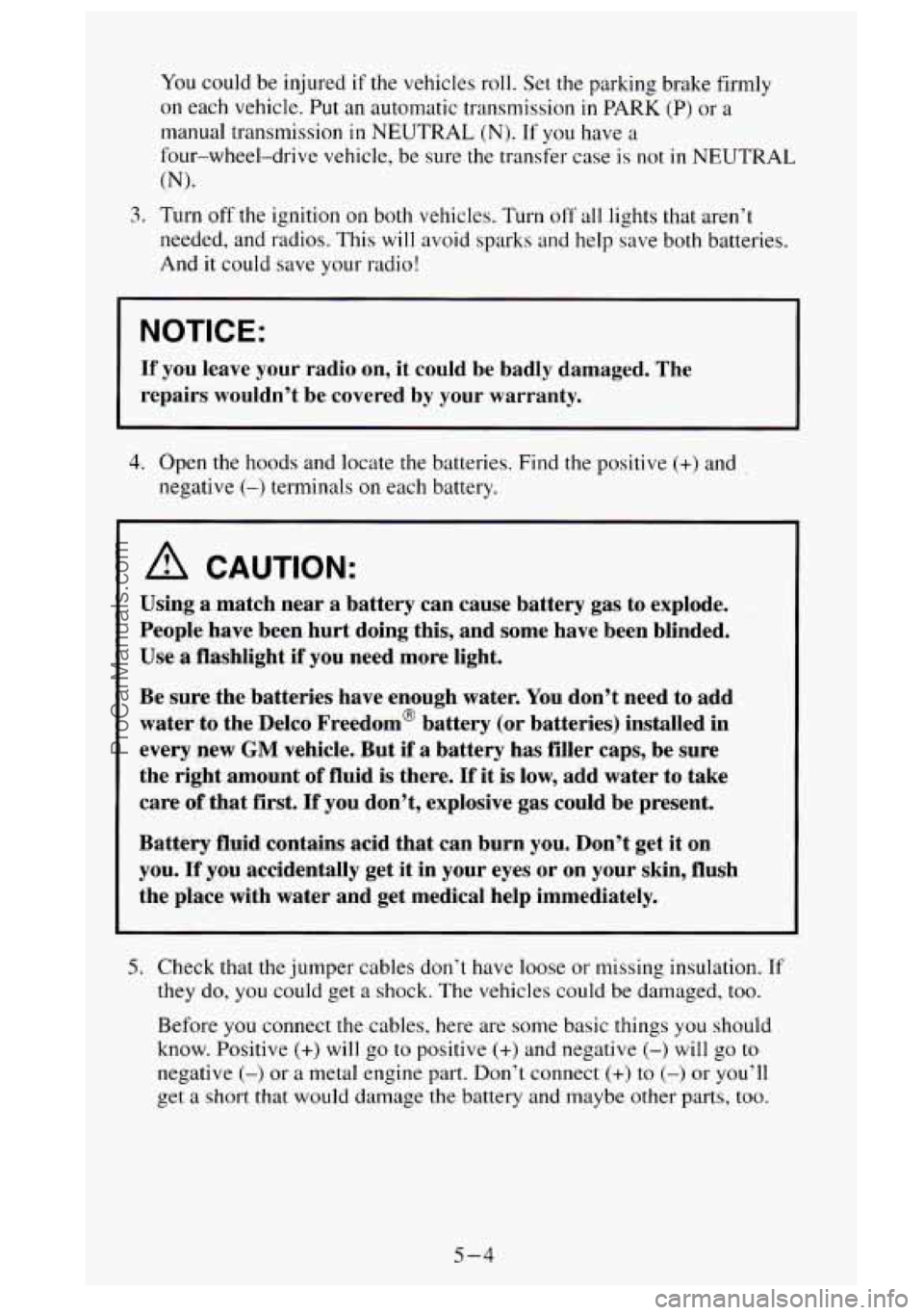
You could be injured if the vehicles roll. Set the parking brake firmly
on each vehicle. Put an automatic transmission in PARK (P) or a
manual transmission in NEUTRAL (N). If you have a
four-wheel-drive vehicle, be sure the transfer case is not in NEUTRAL
(N).
3. Turn off the ignition on both vehicles. Turn off all lights that aren’t
needed, and radios. This
will avoid sparks and help save both batteries.
And it could save your radio!
NOTICE:
If you leave your radio on, it could be badly damaged. The
repairs wouldn’t be covered by your warranty.
4. Open the hoods and locate the batteries. Find the positive (+) and
negative
(-) terminals on each battery.
A CAUTION:
Using a match near a battery can cause battery gas to explode.
People have been hurt doing this, and some have been blinded.
Use
a flashlight if you need more light.
Be sure the batteries have enough
water. You don’t need to add
water to the Delco Freedom@ battery (or batteries) installed in
every new
GM vehicle. But if a battery has filler caps, be sure
the right amount of fluid is there.
If it is low, add water to take
care
of that first. If you don’t, explosive gas could be present.
Battery fluid contains acid that can burn you. Don’t get
it on
you.
ff you accidentally get it in your eyes or on your skin, flush
the place with water and get medical help immediately.
5. Check that the jumper cables don’t have loose or missing insulation. If
they do,
you could get a shock. The vehicles could be damaged, too.
Before you connect the cables, here are some basic things you should
know. Positive
(+) will go to positive (+) and negative (-) will go to
negative
(-) or a metal engine part. Don’t connect (+) to (-) or you’ll
get
a short that would damage the battery and maybe other parts, too.
5-4
ProCarManuals.com
Page 272 of 488
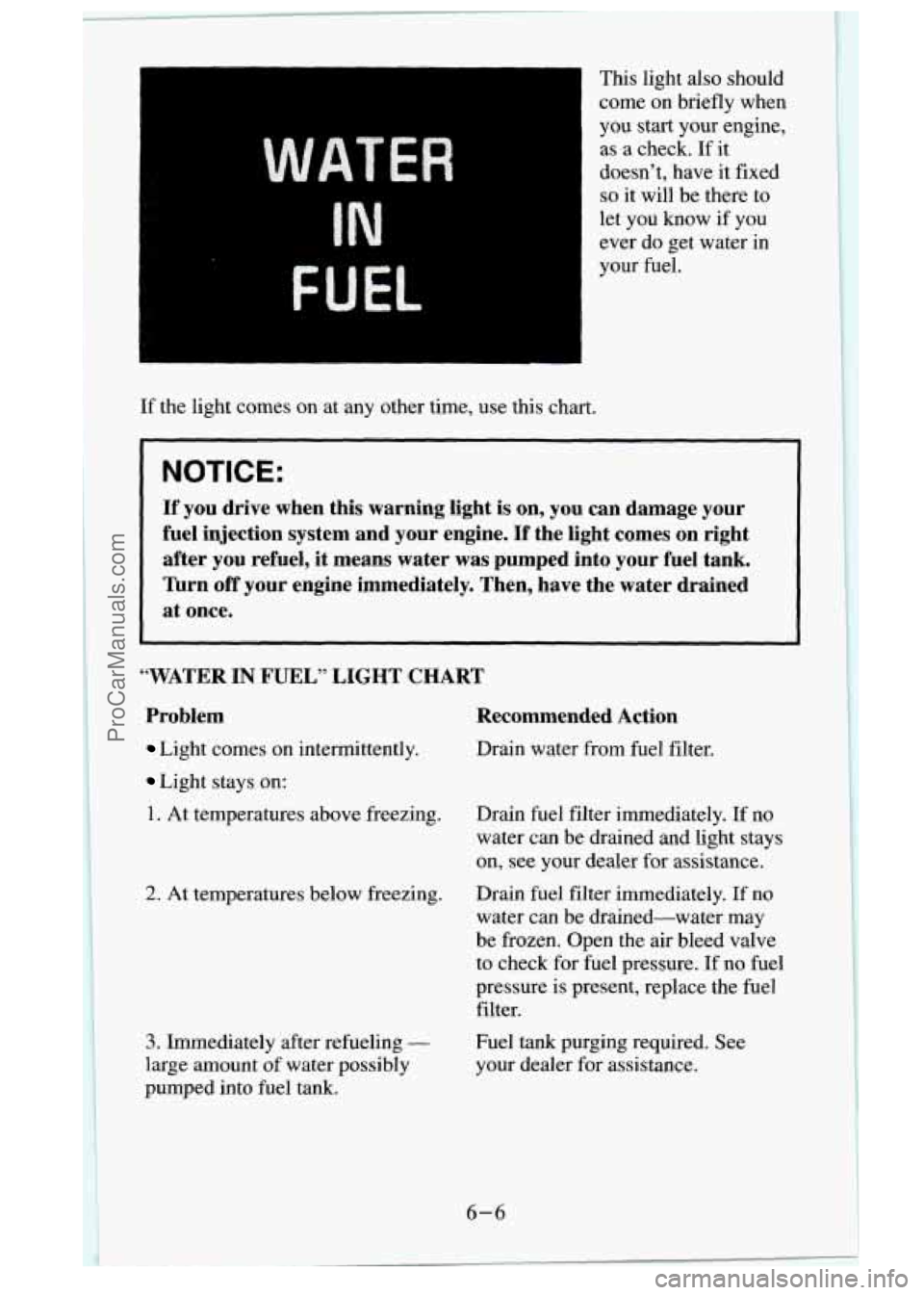
L
WATER
IN
FUEL
If the light comes on at any other time, use this chart. This light also should
come on briefly when
you start your engine,
as
a check. If it
doesn’t, have it fixed
so it will be there to
let you know if you
ever do get water in
your fuel.
If you drive when this warning light is on, you can damage your
fuel injection system and your engine.
If the light comes on right
after you refuel,
it means water was pumped into your fuel tank.
Turn
off your engine immediately. Then, have the water drained
at once.
“WATER IN FUEL” LIGHT CHART
Problem Recommended Action
Light comes on intermittently. Drain water from fuel filter.
Light stays on:
1. At temperatures above freezing.
2. At temperatures below freezing.
3. Immediately after refueling -
large amount of water possibly
pumped into
fuel tank. Drain fuel filter
immediately.
If no
water can be drained and light stays
on, see your dealer for assistance.
Drain fuel filter immediately.
If no
water can be drained-water may
be frozen. Open the air bleed valve
to check for fuel pressure.
If no fuel
pressure is present, replace the fuel
filter.
Fuel tank purging required. See
your dealer for assistance.
6-6
ProCarManuals.com
Page 304 of 488
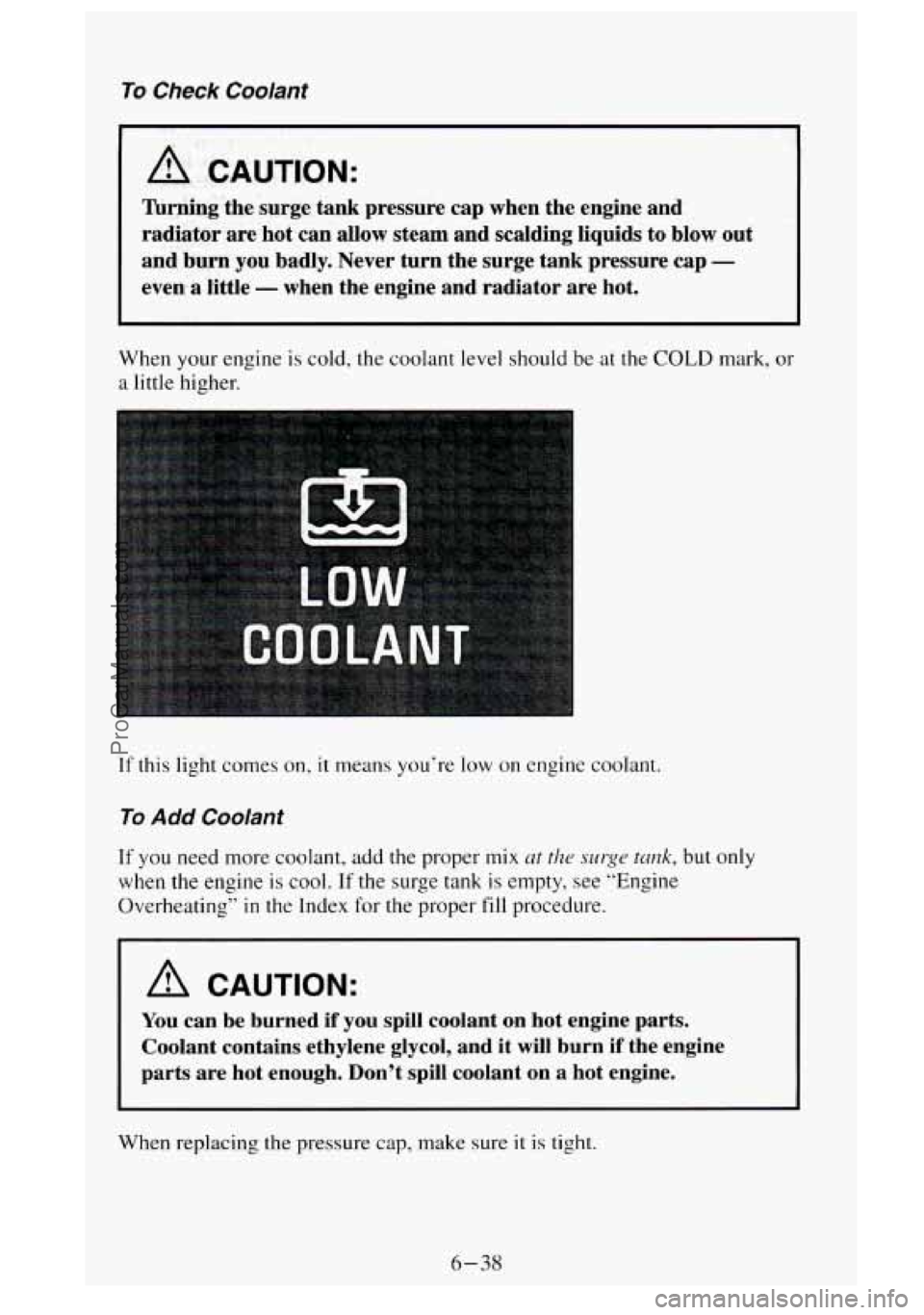
To Check Coolant
A CAUTION:
Turning the surge tank pressure cap when the engine and
radiator are hot can allow steam and scalding liquids to blow out
and burn you badly. Never turn the surge tank pressure cap
-
even a little - when the engine and radiator are hot.
When your engine is cold, the coolant level should be at the COLD mark, or
a little higher.
If this light comes on, it means you’re low on engine coolant.
To Add Coolant
If you need more coolant, add the proper mix ut the surge tmk, but only
when the engine is cool. If the surge tank is empty, see “Engine
Overheating”
in the Index for the proper fill procedure.
A CAUTION:
You can be burned if you spill coolant on hot engine parts.
Coolant contains ethylene glycol, and
it will burn if the engine
parts are hot enough. Don’t spill coolant on a hot engine.
When replacing the pressure cap, make sure it is tight.
6-38
ProCarManuals.com
Page 359 of 488
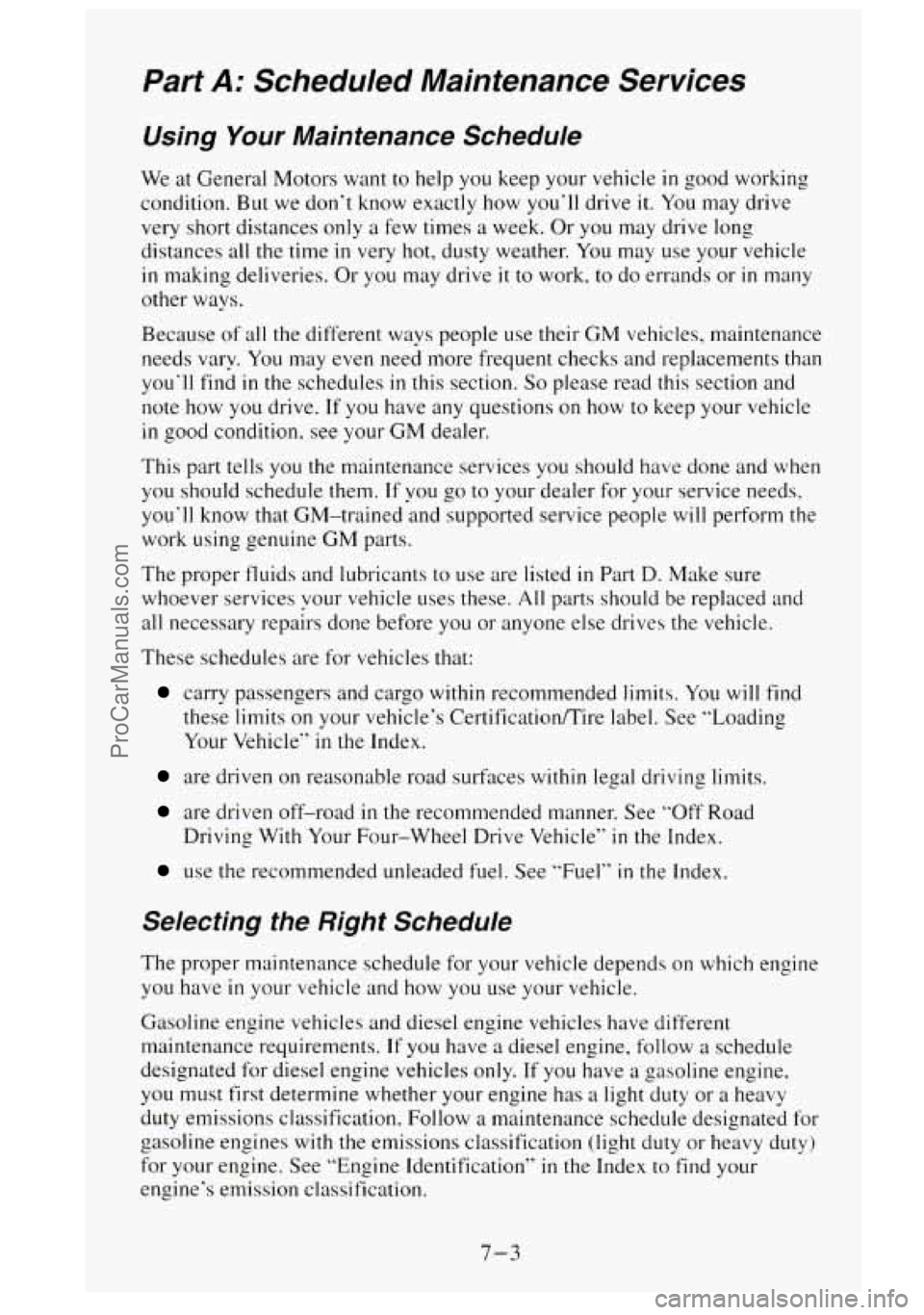
Part A: Scheduled Maintenance Services
Using Your Maintenance Schedule
We at General Motors want to help you keep your vehicle in good working
condition. But we don’t know exactly how you’ll drive it. You may drive
very short distances only
a few times a week. Or you may drive long
distances all the time
in very hot, dusty weather. You may use your vehicle
in making deliveries. Or you may drive it to work, to do errands or in many
other ways.
Because
of all the different ways people use their GM vehicles, maintenance
needs varv.
You may even need more frequent checks and replacements than
you‘ll find
in the schedules in this section. So please read this section and
note how you drive. If you have any questions on how to keep your vehicle
in good condition. see your GM dealer.
This part tells you the maintenance services you should have done and
when
you should schedule them. If you go to your dealer for your service needs,
you’ll know that GM-trained and supported service people
will perform the
work using genuine
GM parts.
The proper fluids and lubricants to use are listed
in Part D. Make sure
whoever services your vehicle uses these.
All parts should be replaced and
all necessary repairs done before you or anyone else drives the vehicle.
These schedules are for vehicles that:
carry passengers and cargo within recommended limits. You will find
these limits on your vehicle’s CertificatiodTire label. See “Loading
Your Vehicle“
in the Index.
are driven on reasonable road surfxes within legal driving limits.
are driven off-road in the recommended manner. See “Off Road
Driving With Your Four-wheel Drive Vehicle”
in the Index.
use the recommended unleaded fuel. See “Fuel” in the index.
Selecting the Right Schedule
The proper maintenance schedule for your vehicle depends on which engine
you have
in your vehicle and how you use your vehicle.
Gasoline engine vehicles and diesel engine vehicles have different
maintenance requirements.
If you have a diesel engine, follow a schedule
designated for diesel engine vehicles only. If you have
a gasoline engine.
you must first determine whether your engine has
a light duty or a heavy
duty emissions classification. Follow a maintenance schedule designated
for
for your engine. See “Engine Identification” in the Index to find your
engine‘s emission classification.
c easoline engines with the emissions classification (light duty or heavy duty)
7-3
ProCarManuals.com
Page 361 of 488
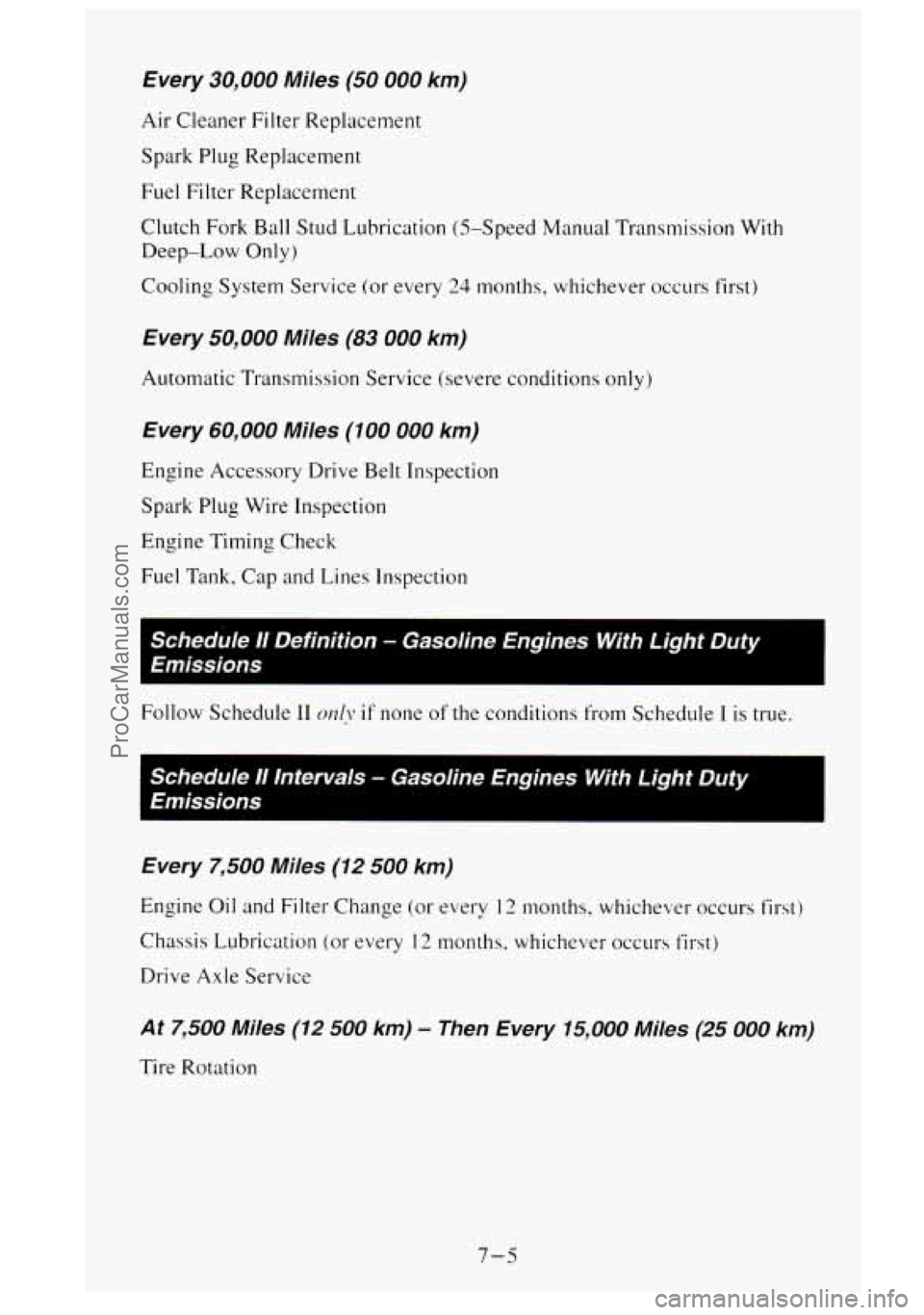
Every 30,000 Miles (50 000 km)
Air Cleaner Filter Replacement
Spark Plug Replacement
Fuel Filter Replacement
Clutch
Fork Ball Stud Lubrication (5-Speed Manual Transmission With
Deep-Low Only)
Cooling System Service (or every
24 months, whichever occurs first)
Every 50,000 Miles (83 000 km)
Automatic Transmission Service (severe conditions only)
Every 60,000 Miles (100 000 km)
Engine Accessory Drive Belt Inspection
Spark Plug Wire Inspection
Engine Timing Check
Fuel Tank, Cap and Lines Inspection
Schedule 11 Definition - Gasoline Engines With Light Duty
Emissions
Follow Schedule I1 only if none of the conditions from Schedule I is true.
Schedule I1 Intervals - Gasoline Engines With Light Duty
Emissions
Every
7,500 Miles (12 500 km)
Engine Oil and Filter Change (or every 12 months, whichever occurs first)
Chassis Lubrication (or every
12 months, whichever occurs first)
Drive Axle Service
At 7,500 Miles (12 500 km) - Then Every 15,000 Miles (25 000 km)
Tire Rotation
7-5
ProCarManuals.com
Page 368 of 488
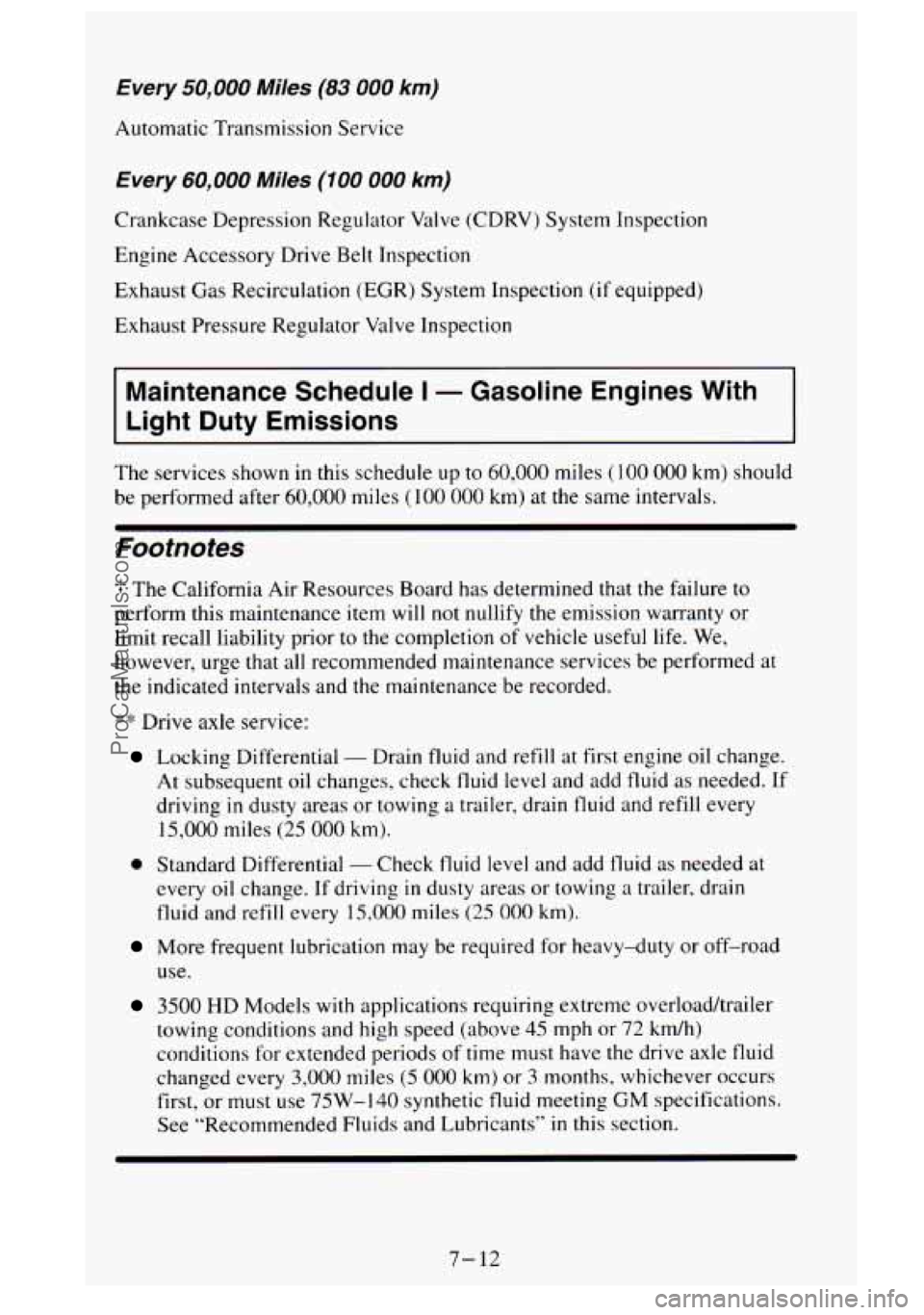
Every 50,000 Miles (83 000 km)
Automatic Transmission Service
Every 60,000 Miles (100 000 km)
Crankcase Depression Regulator Valve (CDRV) System Inspection
Engine Accessory Drive Belt Inspection
Exhaust Gas Recirculation (EGR) System Inspection
(if equipped)
Exhaust Pressure Regulator Valve Inspection
Maintenance Schedule I - Gasoline Engines With
Light
Duty Emissions
The services shown in this schedule up to 60,000 miles (1 00 000 km) should
be performed after
60,000 miles (100 000 km) at the same intervals.
Footnotes
3 The California Air Resources Board has determined that the failure to
perform this maintenance item will not nullify the emission warranty or
limit recall liability prior to the completion of vehicle useful life. We,
however, urge that all recommended maintenance services be performed at
the indicated intervals and the maintenance be recorded.
:$* Drive axle service:
Locking Differential - Drain fluid and refill at first engine oil change.
At subsequent oil changes, check fluid level and add fluid
as needed. If
driving in dusty areas or towing a trailer, drain fluid and refill every
15,000 miles (25 000 km).
0 Standard Differential - Check fluid level and add fluid as needed at
every oil change.
If driving in dusty areas or towing a trailer, drain
fluid and refill every 15,000 miles (25 000 km).
More frequent lubrication may be required for heavy-duty or off-road
use.
3500 HD Models with applications requiring extreme overload/trailer
towing conditions and high speed (above
45 mph or 72 kmh)
conditions for extended periods of time must have the drive axle fluid
changed every
3,000 miles (5 000 km) or 3 months, whichever occurs
first, or must use
75W-140 synthetic fluid meeting GM specifications.
See “Recommended Fluids and Lubricants”
in this section.
7-12
ProCarManuals.com
Page 369 of 488
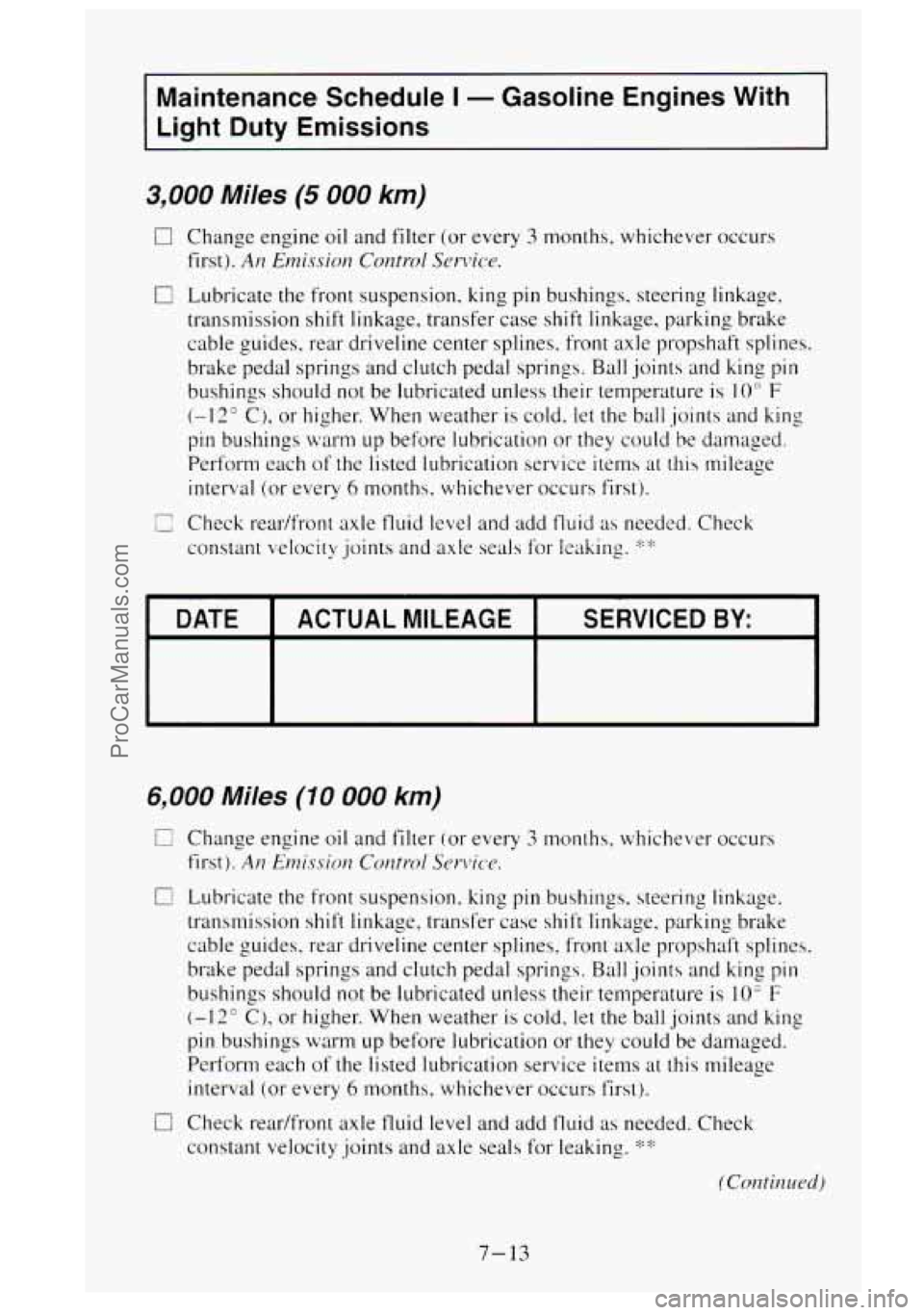
Maintenance Schedule I - Gasoline Engines With
Light Duty Emissions
3,000 Miles (5 000 km)
[7 Change engine oil and filter (or every 3 months, whichever occurs
first).
An Emission Control Sen7ic.e.
0 Lubricate the front suspension, king pin bushings, steering linkage,
transmission shift linkage. transfer case shift linkage, parking brake
cable guides, rear driveline center splines. front axle propshaft splines.
brake pedal springs and clutch pedal springs. Ball joints and king pin
bushings should not be lubricated unless their temperature is
10" F
(-1 2" C), or higher. When weather is cold, let the ball -joints and king
pin bushings warm up before lubrication or they could be damaged.
Perform each of the listed lubrication service items at this mileage
interval (or every
6 months, whichever occurs first).
C Check rear/front axle fluid level and add -fluid as needed. Check
constant velocity joints and
axle seals for leaking. *'*
DATE SERVICED BY: ACTUAL MILEAGE I
6,000 Miles (10 000 km)
iI Change engine oil and filter (or every 3 months, whichever occurs
first).
AI? Emission Confro1 Ser\lic.e.
Lubricate the front suspension, king pin bushings, steering linkage,
transmission shift linkage, transfer case shift linkage, parking brake
cable guides, rear driveline center splines, front axle propshaft splines.
brake pedal springs and clutch pedal springs. Ball joints and king pin
bushings should not be lubricated unless their temperature
is 10" E
(,-12" C), or higher. When weather is cold, let the ball joints and king
pin bushings warm up before lubrication
or they could be damaged.
Perform each of the listed lubrication service items at this mileage
interval (or every
6 months, whichever occurs first).
0 Check readfront axle fluid level and add fluid as needed. Check
constant velocity joints and axle seals for leaking.
*'$
(Contiwed)
7-13
ProCarManuals.com
Page 370 of 488
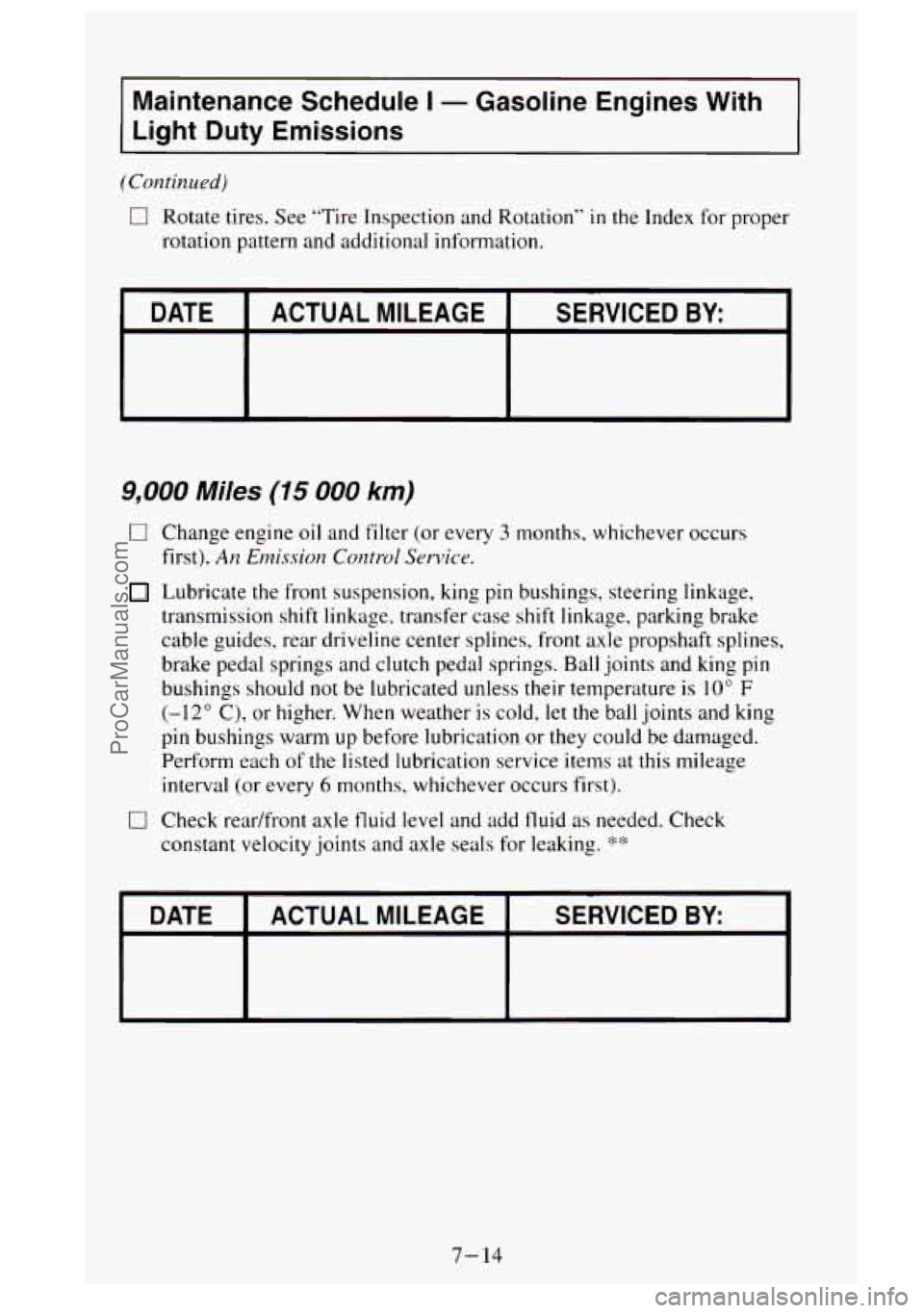
Maintenance Schedule I - Gasoline Engines With
Light
Duty Emissions ~~~~ ~~ ~ ~
(Continued)
0 Rotate tires. See "Tire Inspection and Rotation" in the Index for proper
rotation pattern and additional information.
I DATE I ACTUAL MILEAGE I SERVICED BY:
9,000 Miles (15 000 km)
0 Change engine oil and filter (or every 3 months, whichever occurs
first).
An Emission Control Service.
Lubricate the front suspension, king pin bushings, steering linkage,
transmission shift linkage, transfer case shift linkage, parking brake
cable guides, rear driveline center splines, front axle propshaft splines,
brake pedal springs and clutch pedal springs. Ball joints and king pin
bushings should
not be lubricated unless their temperature is IO" F
(-12" C), or higher. When weather is cold, let the ball joints and king
pin bushings warm up before lubrication or they could be damaged.
Perform each of the listed lubrication service items at this mileage
interval
(or every 6 months, whichever occurs first).
0 Check readfront axle fluid level and add fluid as needed. Check
constant velocity joints and axle seals for leaking.
*'g
DATE SERVICED BY: ACTUAL MILEAGE
7-14
ProCarManuals.com